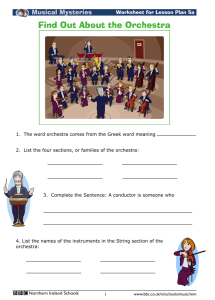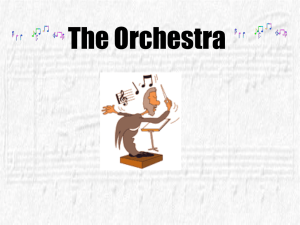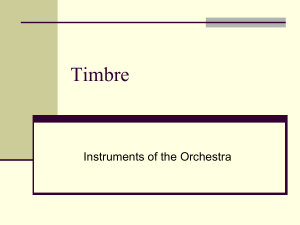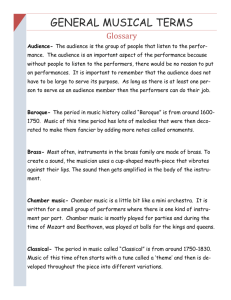Bass Drum - The bass drum is a percussion instrument. Sound is
advertisement
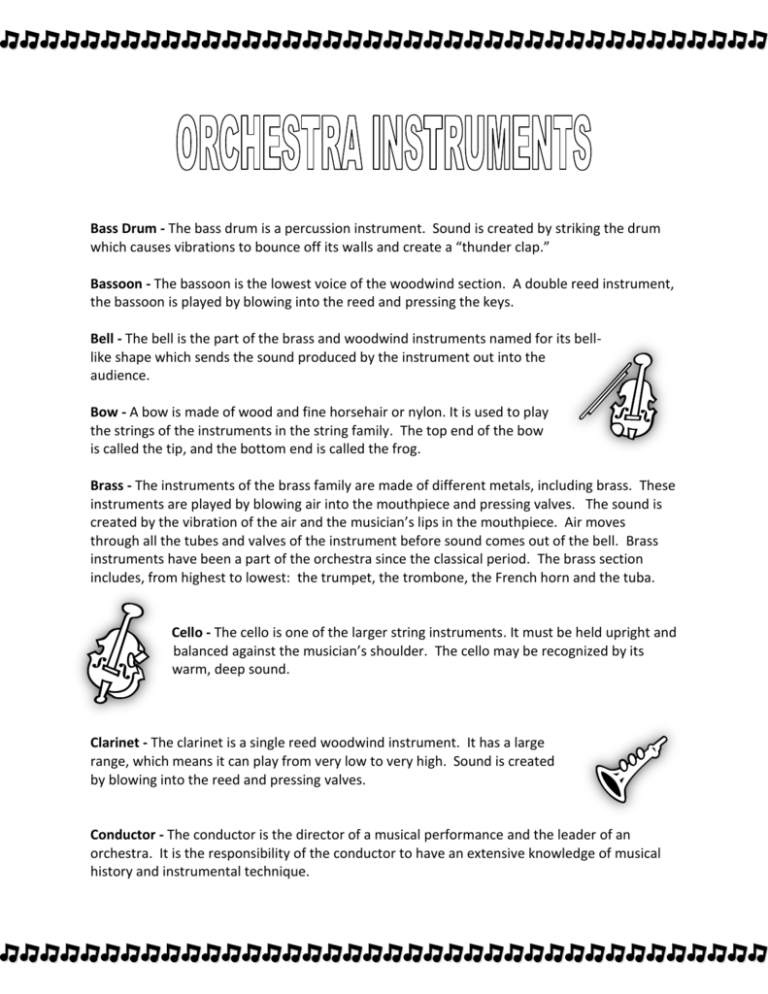
Bass Drum - The bass drum is a percussion instrument. Sound is created by striking the drum which causes vibrations to bounce off its walls and create a “thunder clap.” Bassoon - The bassoon is the lowest voice of the woodwind section. A double reed instrument, the bassoon is played by blowing into the reed and pressing the keys. Bell - The bell is the part of the brass and woodwind instruments named for its belllike shape which sends the sound produced by the instrument out into the audience. Bow - A bow is made of wood and fine horsehair or nylon. It is used to play the strings of the instruments in the string family. The top end of the bow is called the tip, and the bottom end is called the frog. Brass - The instruments of the brass family are made of different metals, including brass. These instruments are played by blowing air into the mouthpiece and pressing valves. The sound is created by the vibration of the air and the musician’s lips in the mouthpiece. Air moves through all the tubes and valves of the instrument before sound comes out of the bell. Brass instruments have been a part of the orchestra since the classical period. The brass section includes, from highest to lowest: the trumpet, the trombone, the French horn and the tuba. Cello - The cello is one of the larger string instruments. It must be held upright and balanced against the musician’s shoulder. The cello may be recognized by its warm, deep sound. Clarinet - The clarinet is a single reed woodwind instrument. It has a large range, which means it can play from very low to very high. Sound is created by blowing into the reed and pressing valves. Conductor - The conductor is the director of a musical performance and the leader of an orchestra. It is the responsibility of the conductor to have an extensive knowledge of musical history and instrumental technique. Concertmaster/Concertmistress - The principal violin player in an orchestra, also known as the “first chair.” The duties of a concertmaster include establishing musical technique in the string section, greeting and representing the orchestra to the public, and tuning instruments for rehearsals and performances. Cymbals - Cymbals are curved bronze disks that come in many sizes. When two cymbals are struck together their edges vibrate, producing a ringing sound. Double Bass - The double bass is the largest and lowest sounding instrument of the string family. The bass was first used in orchestras in the late 1700s. It usually plays parts similar to the cello but sounds an octave lower. Flute - The flute is an instrument that dates back thousands of years. Its origins can be traced all over the world including Imperial Rome, China and India. Although made of metal, the flute belongs to the woodwind family. Sound is created on a flute by blowing a steady stream of air across the mouth piece. Pitch is altered by changing the force of the air and by pressing the valves. In an orchestra the flute generally plays the same notes as the violin. French Horn - The French horn was originally used to call hounds back to their masters and appeared in the orchestra during the Classical period. It has a very large range and is the only brass instrument with a circular shape. Harp - The harp is one of the earliest known musical instruments. Discoveries have shown a harp-like instrument on rock paintings dating back to 15,000 B.C. Many believe that the earliest harps came from the sound of the hunter's bow. The harp is played by plucking strings of varying sizes. Oboe - The oboe is a double reed woodwind instrument invented during the 1600s. To create sound, the musician must blow onto the reed using the correct amount of force for it to vibrate while pressing the valves to alter the pitch. Orchestra - The orchestra as we know it emerged in Europe during the Baroque period of the 1600s. Orchestras consist of four families of instruments: strings, woodwinds, brass and percussion. Although size may vary, an orchestra generally consists of 100 instruments, the majority of which are strings. Piano - The piano is a keyboard instrument whose strings are struck with hammers when the keys are pressed. Thus, the piano belongs to the percussion family. Percussion - The percussion family is the largest family in the orchestra. There are a variety of percussion instruments and each creates sound by any action that would cause vibrations, such as hitting, shaking or scraping. Percussion instruments may be made from wood, metal, animal skin and acrylic materials. An orchestral percussion section consists of a large variety of instruments of all shapes and sizes. This section is responsible for keeping the rhythm and following the tempo of the conductor. Pizzicato - Pizzicato is the musical term for the method of playing a string instrument by plucking the strings with the fingers instead of using a bow. Reed - The reed is a thin piece of wood or plastic that sends vibrations into an instrument to create sound. Reeds vary in size and thickness; each creates a unique tone and pitch. Two reeds may be put together to create a double reed. The double reed produces more vibrations which, in turn, create sound. Saxophone - The saxophone is classified as a woodwind but serves as a cross between a woodwind and a brass instrument. The saxophone has a single reed and a mouthpiece like a clarinet, but it has a metal body with a flared bell. Saxophones produce a strong, mellow sound. Snare Drum - The snare is a small percussion instrument. Sound is made by striking the instrument which, in turn, causes wires inside to vibrate. Strings - The instruments of the string family make up the largest section of the orchestra. These instruments include the violin, viola, cello and bass. Musicians create sound on string instruments by bowing the strings with a bow or by plucking the strings with the fingers. Timpani - Timpani are instruments of the percussion family. They are large barrel-shaped drums covered with a skin called a head. Timpani are played by striking the head with various mallets. Timpani are one of several percussion instruments which can be tuned to produce pitch when struck. Triangle - The triangle is a small instrument belonging to the percussion family. It consists of a steel rod in the shape of a triangle. While the triangle is among the smallest of the orchestra instruments, it has a very clear sound that can be heard above the other instruments. Trombone - The trombone is the middle voice of the brass family. Like all brass instruments, the trombone moves air though tubing. Instead of valves, the trombone has a sliding arm, called the slide. The airflow through the tubing is lengthened or shortened by moving the slide out or in, which causes the pitch to change. Trumpet - The trumpet is the smallest instrument in the brass family. It is also the highest pitched of the brass instruments. The shape of the trumpet’s bell creates a clear sound which can be heard amongst the other instruments in an orchestra. Tuba - The tuba is the largest instrument in the brass family. It is also the lowest pitched of the brass instruments. The tuba requires a large amount of air to pass into the mouthpiece and through the tubing to create sound. Valves - The valves are the buttons or keys of the woodwinds and brass instruments that, when pressed or released, allow the player to change the length of the air column of a brass instrument thus changing the pitch. Viola - The viola is an instrument of the string family. The viola looks similar to the violin and is played in the same manner, but is slightly larger with a deeper sound. Violin - The violin is a four-stringed instrument of the string family. The violin serves as the highest voice of the stringed instruments. Woodwinds - The woodwind family includes the flute, clarinet, oboe, bassoon and saxophone. The woodwinds are wind instruments which produce sound by the vibration of a reed or the passing of air across a mouthpiece.

